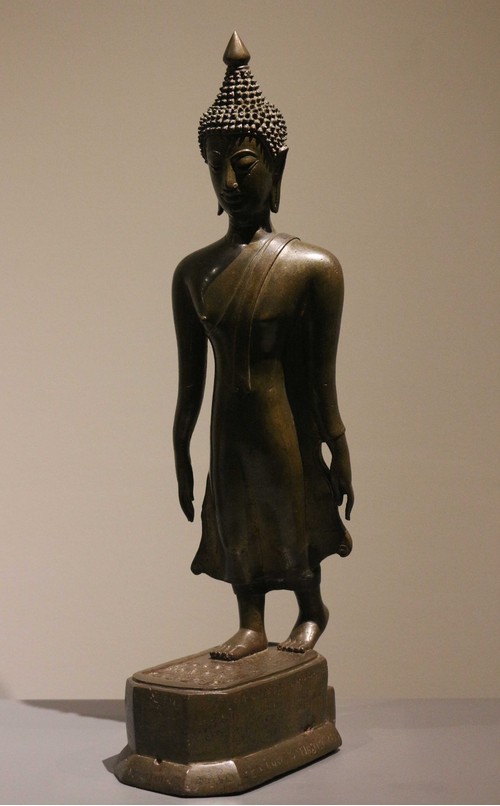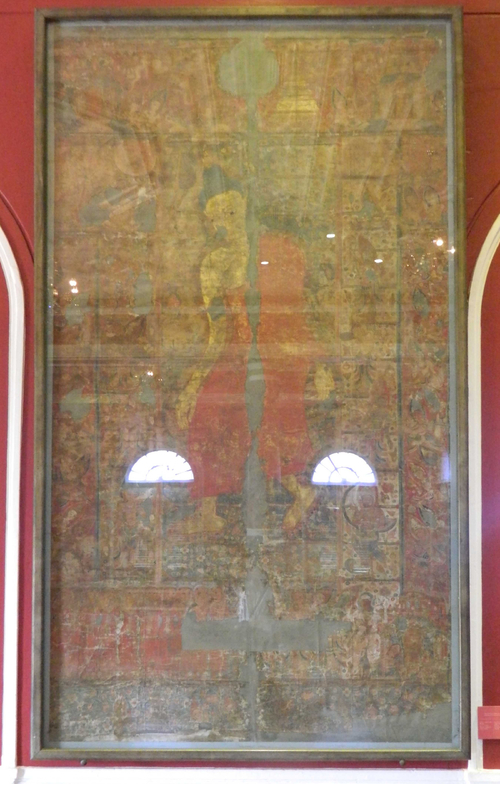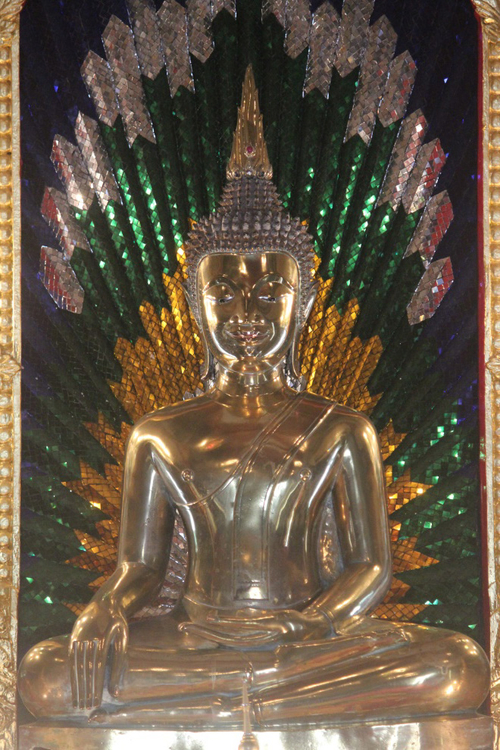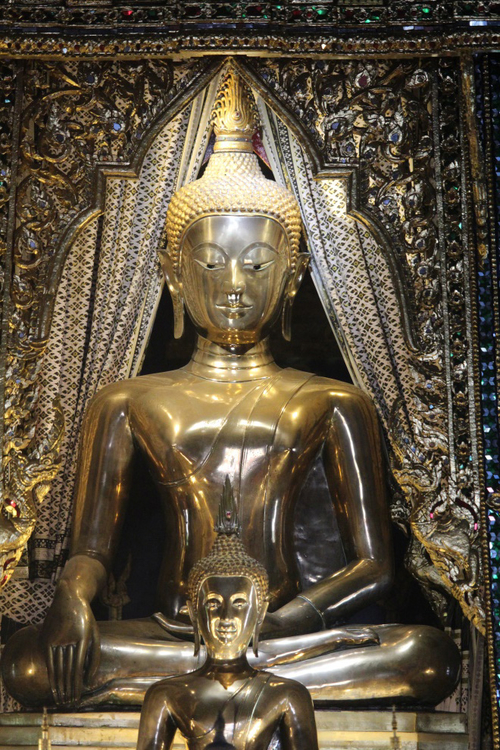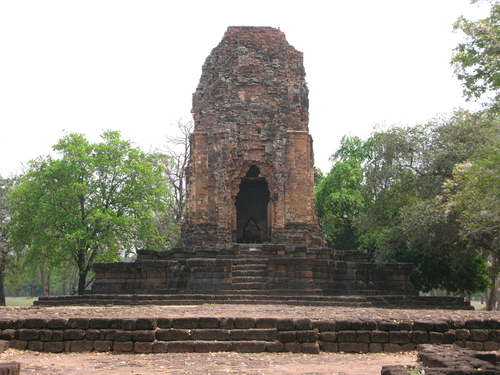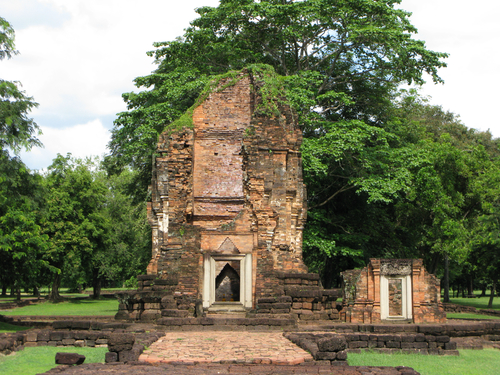ค้นหางานศิลปกรรม
ฐานข้อมูลศิลปกรรมในเอเชียตะวันออกเฉียงใต้
ประติมากรรมพระพุทธรูปปางกดรอยพระบาท
พระพุทธรูปองค์ประทับยืนในอิริยาบถลีลา พระพักตร์เล็ก ขมวดพระเกศาใหญ่ อุษณีษะทรงสูงอย่างมาก ยอดอุษณีษะเป็นตุ่มกลมคล้ายดอกบัวตูม พระเนตรเหลือบต่ำ พระโอษฐ์แย้ม พระวรกายเพรียวบาง ชายสังฆาฏิยาวจรดพระนาภีปลายตัดตรง พระกรทั้งสองข้างปล่อยลงไปตรงๆ พระบาทขวากดประทับลงบนฐานที่มีรอยพระพุทธบาทปรากฏอยู่ 3 รอย
จิตรกรรมพระบฏวัดดอกเงิน
พระบฏผืนนี้เขียนเรื่องพระพุทธเจ้าเสด็จลงจากสวรรค์ชั้นดาวดึงส์สู่เมืองสังกัสสะ สีที่ใช้มีหลายสี เช่น สีเขียว สีน้ำเงิน สีแดง สีขาว สีดินเหลืองและสีดำ ปิดทองเฉพาะองค์พระพุทธเจ้า ภาพแบ่งออกเป็น 4 ช่วง ช่วงบนสุดเป็นภาพสวรรค์ชั้นดาวดึงส์ แสดงภาพเทวดาประคองอัญชลี มีต้นปาริชาติ เจดีย์จุฬามณี และวิมาน 2 หลังคือเวชยันต์ปราสาทและสุธรรมเทวสภา ชั้นที่สองเป็นภาพพระพุทธเจ้าขนาดใหญ่อิริยาบถลีลาลงจากบันไดแก้ว มีพระอาทิตย์และพระจันทร์ขนาบสองข้างพระเศียร ด้านซ้ายแสดงภาพเทวดาจากสวรรค์ชั้นดาวดึงส์เสด็จลงบันไดเงิน ด้านขวาแสดงภาพพรหมเสด็จลงบันไดทอง ขอบทั้งสองด้านแสดงภาพเทวดาชั้นรองถือเครื่องสักการะเหาะตามมา ชั้นที่สามแสดงภาพเมืองสังกัสสะ ฝั่งขวาคือแถวพระสงฆ์ ฝั่งซ้ายคือกลุ่มกษัตริย์ยืนรอรับเสด็จ และยังมีภาพบุคคลอื่นๆ เช่น พราหมณ์ ขุนนางประคองอัญชลีและมีภาพปราสาท ด้านล่างสุดเป็นภาพน้ำ มีมนุษยนาคประคองอัญชลี ฉากหลังเป็นดอกมณฑารพ มีจารึกอักษรฝักขามตามตำแหน่งต่างๆ
ประติมากรรมพระใส
พระพุทธรูปองค์นี้ประทับนั่งขัดสมาธิราบปางมารวิชัย ขมวดพระเกศาเล็ก รัศมีเป็นเปลวไฟ พระพักตร์ค่อนข้างใหญ่ พระเนตรใหญ่หรี่ลงต่ำ พระนาสิกใหญ่มากส่วนยอดพระนาสิกตัด พระโอษฐ์กว้างยิ้มแบบล้านช้าง พระหัตถ์ค่อนข้างใหญ่เทอะทะ นิ้วพระหัตถ์ค่อนข้างใหญ่ยาวเท่ากัน
ประติมากรรมพระเสริม
พระพุทธรูปองค์นี้ประทับนั่งขัดสมาธิราบปางมารวิชัย ขมวดพระเกศาเล็ก รัศมีเป็นเปลวไฟ พระพักตร์รูปไข่และเล็ก พระนลาฏแคบ พระขนงโก่ง พระนาสิกเล็กและโด่ง พระวรกายบอบบาง สังฆาฏิเป็นแผ่นใหญ่ยาวถึงพระนาภีปลายคล้ายเขี้ยวตะขาบ นิ้วพระหัตถ์เล็กเรียวยาวเสมอกัน
สถาปัตยกรรมเจดีย์ประธาน วัดเชียงงาสง่างาม
เจดีย์องค์นี้เป็นเจดีย์ทรงระฆัง ส่วนฐานเป็นบัวถลาในผังยกเก็จต่อด้วยบัวคลุ่ม องค์ระฆังในผังกลมมีการประดับบัวคอเสื้อ ส่วนยอดทำเป็นเจดีย์จำลอง
สถาปัตยกรรมศาลตาผาแดง
เป็นปราสาทแบบเขมรก่อด้วยศิลาแลงขนาดใหญ่ที่นิยมใช้ในงานก่อสร้างในวัฒนธรรมเขมร ส่วนยอดพังทลายไปแล้ว เหลือแต่ส่วนห้องที่เคยประดิษฐานรูปเคารพกับมุขทางเข้าที่เชื่อมต่อ หันหน้าไปทางทิศตะวันออก ส่วนล่างของอาคารเริ่มจากชั้นเขียงรองรับฐานบัวลูกฟัก เหนือจากฐานขึ้นไปคือเรือนธาตุทรงสี่เหลี่ยมจัตุรัสเพิ่มมุม และต่อมุขออกไปทางตะวันออก โดยมีบันไดทางขึ้นอยู่หน้ามุข อันเป็นแบบอย่างของปราสาทเขมรเช่นกัน ซึ่งต่อมาลักษณะดังกล่าวนี้ช่างสุโขทัยจะเลือกนำไปปรับปรุงอยู่ในเจดีย์รูปทรงใหม่ของตน ก่อนหน้านี้คงสร้างขึ้นในศาสนาฮินดูหรือศาสนาพุทธฝ่ายมหายาน ต่อขึ้นไปคือส่วนบนซึ่งพังทลายลงหมดแล้ว เชื่อว่าส่วนบนของปราสาทเป็นทรงแท่ง มีชั้นซ้อนเช่นเดียวกับปราสาทเขมรโดยทั่วไป
สถาปัตยกรรมปรางค์ศรีเทพ
โบราณสถานปรางค์ศรีเทพประกอบด้วยปราสาทประธาน บรรณาลัย โคปุระ กำแพง ชานชาลาหรือทางเดินรูปกากบาท สะพานนาค และอาคารรูปสี่เหลี่ยมผืนผ้าที่ทอดยาวขนานกับสะพานนาคปราสาทประธานเป็นปราสาทอิฐในผังสี่เหลี่ยมเพิ่มมุม ตั้งอยู่บนฐานบัวลูกฟักสองชั้นก่อด้วยศิลาแลง ประตูทางเข้าอยู่ทางด้านทิศตะวันออก ที่เหลืออีกสามด้านเป็นประตูหลอก ภายในของประตูหลอกทำเป็นช่องหรือซุ้มที่ประดิษฐานประติมากรรมรูปเคารพปัจจุบันตัวปราสาทไม่เหลือร่องรอยหรือชิ้นส่วนประดับสถาปัตยกรรม เดิมคงมีหลังคาเครื่องไม้คลุมที่ด้านหน้าอาคารเนื่องจากที่พื้นของฐานบัวลูกฟักชั้นล่างพบร่องรอยหลุมเสากลมขนาดใหญ่ และกระเบื้องมุงหลังคาดินเผาเป็นจำนวนมาก จากหลักฐานโบราณวัตถุที่พบในบริเวณปรางค์ศรีเทพได้แก่ เทวรูปพระอิศวร 4 กร จึงกำหนดอายุปรางค์ศรีเทพอยู่ในราวพุทธศตวรรษที่ 16-17
สถาปัตยกรรมปรางค์สองพี่น้อง
รูปแบบสถาปัตยกรรมเป็นปราสาทเขมร ก่อด้วยอิฐไม่สอปูน มีร่องรอยปูนฉาบที่ผนังด้านนอก แผนผังประกอบด้วยปราสาทสองหลังตั้งอยู่ใกล้กันในแนวเหนือ-ใต้บนฐานไพทีเดียวกัน ปราสาททั้งสองหลังหันหน้าไปทางทิศตะวันตก โดยปราสาทหลังใหญ่ที่ตั้งอยู่ทางทิศเหนือของปราสาทองค์เล็กในแผนผังสี่เหลี่ยมเพิ่มมุม มีมุขยื่นออกมาทางด้านทิศตะวันตกซึ่งเป็นช่องประตูทางเข้า อีกสามด้านที่เหลือเป็นประตูหลอก ที่ด้านหน้ามุขปราสาทมีฐานศิลาแลงรูปกากบาท ส่วนหลังคาพังทลายจนไม่เห็นรูปทรง แต่จากการขุดแต่งพบกลีบมะเฟืองประดับหลังคาสลักจากศิลาแลง จึงสันนิษฐานว่าส่วนบนคงทำเป็นเรือนซ้อนชั้นลดหลั่นกันขึ้นไป แต่ละชั้นประดับด้วยนาคปักจนถึงส่วนยอดที่เป็นกลศ รูปทรงโดยรวมของส่วนบนคงเป็นทรงพุ่มเช่นเดียวกับปราสาทหินพิมายหรือพนมรุ้ง อันเป็นพัฒนาการของปราสาทเขมรที่สำคัญในช่วงพุทธศตวรรษที่ 16ปราสาทหลังเล็กทางด้านทิศใต้ แต่เดิมเหลือเพียงส่วนของเรือนธาตุช่วงล่างแต่ได้ซ่อมแซมต่อเติมขึ้นไปเพื่อติดตั้งทับหลังที่พบในบริเวณเดียวกัน วัสดุ และรูปทรงโดยรวมเหมือนกับปราสาทองค์ใหญ่ แต่ได้ลดความซับซ้อนของส่วนฐานและการซ้อนชั้นของเรือนธาตุลง และไม่ได้ก่อมุขยื่นออกมาทางด้านหน้า โบราณวัตถุชิ้นสำคัญที่พบบริเวณปรางค์สองพี่น้อง ได้แก่ ศิวลึงค์ ฐานโยนิ และโคนนทิ ฝังอยู่ใต้ดินในระดับฐานอาคาร จึงสันนิษฐานว่าเดิมปรางค์สองพี่น้องคงเป็นเทวสถานในศาสนาพราหมณ์ไศวนิกาย ซึ่งอาจกำหนดอายุได้ในราวพุทธศตวรรษที่ 17 จากทับหลังและเสาประดับกรอบประตูรูปแบบศิลปะเขมรแบบบาปวนที่พบจากการขุดแต่ง
